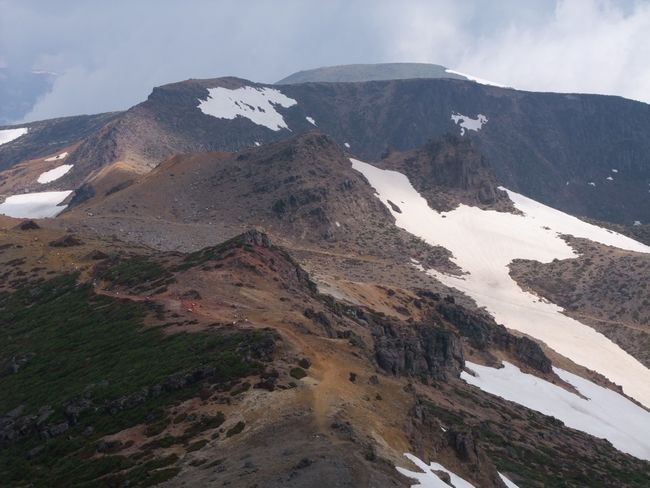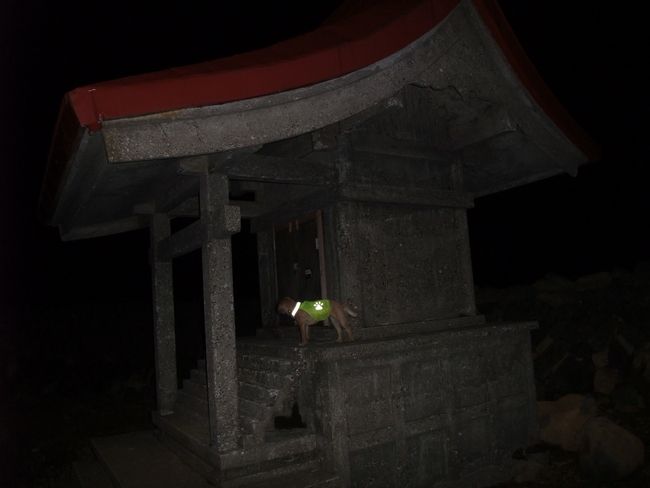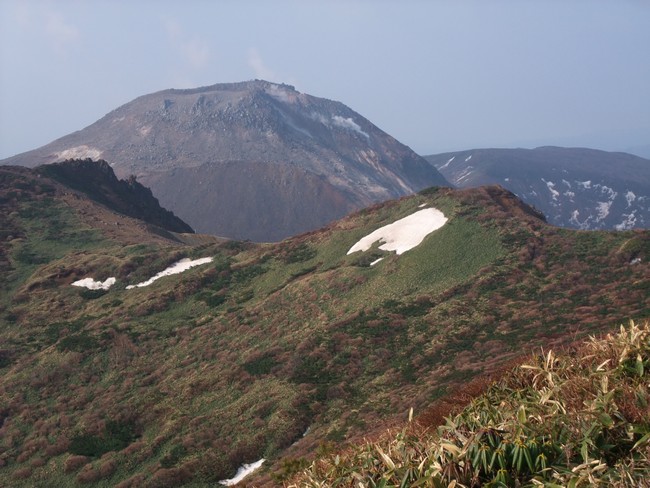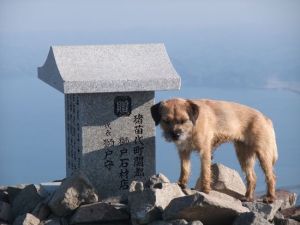It was a struggle to get to sleep. Nothing to do with the back of the car, but the excitement of the day ahead. The moon was melting the last wisps of cloud and I was sure it would be a snow-free day tomorrow, unencumbered by crampons and heavy jacket. Half a bottle of sake put out the lights.
At 3.30, when the irredeemably cheerful cellphone alarm went off, the carpark at the foot of Nasu was awash. Again. It took another hour to decide that things weren’t going to get better, abandon hopes of many peaks, and prepare for a slog. But it was not the weather that was grim, for that soon cleared. Rather, the deep mud of the path and dense undergrowth slowed progress.

There was no one else up here at this time. Not on the summit, not on the descent. Not until within 30 minutes of the start when the first hikers were starting out and the tour buses were arriving. They had missed the exhilaration of the dawn.
Adatara was a walker’s peak, with a cablecar taking out most of the altitude gain and hence attracting the older generations. But it was a surprise to see more than 20 army soldiers walking up, in fatigues and all equipped with a Garmin Etrex poking out of multi-pocketed shirts. Without exception, they immediately stepped off the path to make way for other hikers. Biased perhaps, but I cannot imagine such well-mannered British squaddies.

The map of Azuma shows at least four potential routes. I had planned to take the Northwest route from the back, but the helpful staff at Adatara suggested that the cablecar from the south might be running at a weekend. A quick call to Kin for an internet search brought the good news that it had just started running again today. The game was on again after the late start this morning. Would it be possible after all? I immediately switched from leisure mode, raced to the car, chucked the gear in, emptied some food into Hana’s carrier, and was off. Whenever caught momentarily at traffic lights or behind a slow car, I took the chance to refill the Camelbak, replace the empty Powergels and emergency food, swap the maps, reset the GPS, eat and drink, and calculate the times and possibilities. It was like a triathlon transition. But I had not even considered, let alone study, this south route on Azuma.
I emerged from the top station of the cablecar, relieved that Hana had not been spotted under cover of my jacket and pack. The ticket girl at the bottom had unequivocally confirmed that no climbers had been up today, but in the cavernous cafeteria at the top were two fit-looking men in winter gear, huddled over steaming mugs of coffee with their gear still dripping from the rain. “Have you been up?” I asked.”Yes, we were the first, but the weather wasn’t good.” Easy to find the route? “Sure, just follow the footsteps. But you’re not going now? The last lift down is at 4 pm.” It was 12:30 and they were concerned, but there is no better driving force than a deadline.
At the top of the first peak at 1900 meters, the snow was still burying the tops of the younger pine trees. The rain had turned to fine hail, and I had lost the two men’s tracks amid the trees and mist. It was just 30 minutes, a dip and a rise, to the true peak, but they had warned me that it was easy to get lost. In my haste, I had brought no light, little food, and the sky was a thunderous black, rolling up from where I had come. I did not feel comfortable. This is how accidents happen. “Sounan”. I often wonder how it happens. I did not wish to become a newspaper story. But the GPS clearly showed the route to the peak and there was no objective danger, other than plunging into any of the tapering 3-meter deep holes around the tree trunks and getting sandwiched. Several years ago we had had to dig out a friend who slipped into such a hole.
Hana was perhaps more elated than me to be bounding back down the slopes, nose to our footprints, leading the way. We were back comfortably within two hours, and just a few kilometers across the lake, Bandai was beckoning to us in the afternoon sunshine.
My images of Ura-Bandai, captured in magazines, had been of frozen lakes and the deepest snow, but the reality by mid May was wonderful hard bare rock. The legs were showing signs of weak instability, and Hana too was no longer racing ahead to attractive smells, but the lack of perceived danger made the climb so much easier and enjoyable.
By the time we reached the base of Zao, it was after 9 pm. There were another couple of cars, and there was a sudden exchange of conversation within the neighbouring SUV. What the heck was a foreigner doing with a dog, setting off into the night? But by now the moon was out again, and in spite of the three to four meters deep snow banks on the roadside, the ridge path was entirely devoid of snow. Without a torch, I walked slowly along the well-maintained path toward the fifth peak of the day,

savouring the exquisite mix of satisfied exhaustion. And we even made it back to the village at the foot of Zao by 10:35 pm, just 10 minutes to spare before the public onsen closed.
This was one of those days for which I thank my mother and father.




The photo of the pine trees in the mist is almost a sumi-e masterpiece. Reminiscent of Sesshu or Tohaku…
And, by the way, well done Hana!
Sumi-e was not what sprang to mind as I tried to pick my way through those trees. A look at the recorded GPS track (http://www.hanameizan.com/log/azuma-map.jpg)
reveals that I had followed the prefectural boundary, not the hiking route. Duh!
ジェイコブス 腕時計